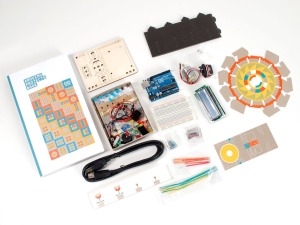Week Ten: How are electronics viable additions to “crafting” for today’s young person?
“From the earliest age, children are fascinated by the movement and lights of objects. As young as months old, children will stare wondrously at these flashing and moving objects, and will watch these for minutes and sometimes even longer. As kids get older they still are often fascinated by moving objects. Young children have spent many hours trying to take toys and other objects apart to see what makes them work.”
Trent Crawford
Alaska State Standards and Ketchikan Gateway Borough School District (KGBSD) Standards for learning indicate the concept of beginning to understand electricity begins in 3rd grade.
“SB2.3 understanding and constructing open, closed, parallel, and series circuits”
I can see how using the materials from Chibitronics and Adafruit a fun easy way to help students understand the concept of electricity. Beyond the standards, electronics can be used to capture student interest, spice up craft projects and enhance lessons. I really like the idea mentioned in Lee’s video on using Chibitronics to make an interactive light up bulletin board.
I know nothing about how to do this stuff. It is one of the reasons I have never volunteered for the Robotics team at school. Watching the videos and reading the articles makes it sound not so intimidating. So how could I use electronics in a kindergarten classroom. Every year we get a little, not a lot, of lighting. The kids are just fascinated by it. the come to school and just can’t stop talking about it. I take this opportunity for a teachable moment to try and explain a little bit about how electricity works. I use my limited drawing skills on the white board to explain. This discussion always leads to a safety talk about the dangers of electricity. With the my discovery of Chibitronics the students could create their own circuits and not just watch me draw them on the whiteboard. I also see using Ladyada’s “E is for Electronics” is a coloring book adventure with electronic components and their inventors. Students of all ages can learn and color as they explore the world of electronics. Coloring book is available for purchase or you can download it for free. The reading is too difficult for kindergarten students but they can enjoy coloring the pictures as the teachers reads the story.
Beyond teaching about electricity I can see using Chibitronics to create interactive alphabet activities. For example you are teaching beginning sounds. You (and students) could create pages where when you touch beginning letter that letter lights up in a corresponding word helping child to make connections. This same idea is transferrable to number, color words, directional words. Touch the right spot and get a light as your reward. I think kids would dig it and stay engaged.
References:
Adafruit. http://www.adafruit.com/products/659
AFA: Using Chibitronics in the English Classroom: Lee Graham. https://www.youtube.com/watch?v=3aGB0_8Y-w4
Chibitronics Site. http://store.chibitronics.com/
Crawford, T. Simple Machines and Electronic Projects for Kids. Sewell Direct. https://sewelldirect.com/learning-center/Simple-Machines-and-Electronic-Projects
Einarson, E. (2013). Go Bionic With These Wearable Arduino Projects. http://www.wired.com/2013/01/wearable-arduinos/
Interactive Light Painting: Pu Gong Ying Tu (Dandelion Painting). https://vimeo.com/40904471
Ketchikan Gateway Borough School District Curriculum Standards. file:///C:/Users/Jane/Downloads/Science_Curriculum_Grade_3_Revised_2011_2012.pdf
Ladyada’s “E is for Electronics”. Adafruit. http://www.adafruit.com/coloringbook
Leah Buechley: How to “sketch” with electronics. https://www.youtube.com/watch?v=vTBp0Z5GPeI
Mellis, D. (2014). Interview with Leah Buechley: Sew Electric. https://blog.arduino.cc/2014/02/04/sew-electric-with-leah-buechley-interview/
Terranova, A. (2014). 10 Fabulous and Fashionable Wearable Projects from Becky Stern. Makezine. http://makezine.com/2014/07/15/10-fabulous-and-fashionable-wearable-projects- from-becky-stern/


That is great that even though you said you do not know much about electronics you volunteered for the Robotics team. There is no better way to learn or overcome fears than to try what we are unsure of. I like your idea of using Chibitronics to create interactive alphabet activities for your kindergarteners.
LikeLiked by 1 person
It’s interesting that your district standards include electronics instruction as early as 3rd grade. The timing seems appropriate since kids are so fascinated by light and motion. It’s also appropriate from a safety perspective. Young kids love to explore new things. Understanding some of the basics about electricity may keep them from exploring too far. I also like the idea of using Chibitronics as a tool to help these young minds learn and explore. It’s a hands-on experience that produces something visually interesting. As you said, kids would be creating their own circuits instead of just watching you draw an example on your white board.
LikeLiked by 1 person
I like your post about the letters in words lighting up. That would be a fun way to teach beginning sounds, and we all know that kids love that stuff. You should sign up for robotics, that is the best way to learn. Tell them you want to be an observer and then you can play with the kids and learn to be a great coach.
LikeLiked by 1 person
Thanks, I just might do that. This class inspired me to step out of my comfort zone and try some new ways of incorporating technology into school.
LikeLike